
Wine Culture and Information since 2002 - Volume 22
 Wine Culture and Information since 2002 - Volume 22 |
|
Issue 36, December 2005 |
Contents |
|
|
Wine? Red, Still and Always Red! |
|
The fact wine is not having a truly good time in consumptions, it certainly is not something new. Despite there are slight but significative signals of change, the world of wine is however far away from the levels of some years ago, when the sellings certainly were higher. Like everyone knows, the trend and evolution of everything and every phenomenon, are characterized by the change of ups and downs, which cyclically repeat themselves, at least as long as there are indispensable conditions for their repetition. This is also true for wine - of course - whose consumption is currently reduced after having had a good time in selling. Without discussing the reason which caused these two extremes, by applying this model, sooner or later - at least we hope so - consumptions will resume and, maybe, they will be even higher than some years ago. This trend is also valid for preferences of consumers: whether some tens of years ago were whites to be preferred by consumers, today are reds the wines which are mainly poured in glasses. In these times, characterized by lower consumptions, wines which seems to better stand to the lowering of selling are reds. Of course, not all reds, as the price factor also plays a fundamental role. In fact, it seems the wines which are mainly preferred by consumers are reds sold at a price of about € 5.00. Whether it is true this price may be justified by general economic conditions, what can justify the preference for red wines? Perhaps it is because red wines are usually produced with higher quality criteria than - for example - white wines? Probably not, because the market offers a good selection of white wines sold at this price, as good as reds. Indeed, we could also add the production of a red wine, in particular when casks are being used, generally has a higher cost than white, therefore a higher price as well. In other words, by using a hypothetical scale of quality and provided it is sold at the same price, a white wine should have a higher quality than a red one. Price, although it conditions the choices of consumers anyway, is evidently not the primary factor in determining the preference for red wines. We should probably find a better explanation in those subtle - however fundamental - factors associated to culture, fashion and the influence of media. In fact, in case it simply was culture to influence the consumption of wine, our preferences would still be for sweet wines, that is for those wines mainly consumed in ancient eras and from which our culture - and our traditions as well - have originated from. Culture - as it is too much obvious - evolves and adapts itself according to social changes, up to reaching nowadays and to our preference for red wine. To tell the truth, taste and the way of making wine has drastically evolved - with the exception of the fundamental wine making principles - and the production processes have strongly been influenced both by technology and chemistry. The taste of wine consumed and produced during ancient Romans times, for example, would hardly meet the taste of modern men. This is particularly true for dry wines, as the taste and the production of modern wines is still based on methods and principles developed during the 1500's and 1600's, the era in which enology strongly evolved. More likely, it is the influence of trends and of fashion - last but not the least - the interest and the attention media put on red wine. To this should also be added the fact - at least since recent times - red wine has always been considered the wine par excellence. If we think about wine, the most frequent association is with red, to which is recognized a fuller body, higher charm, greater dignity and higher authority, in other words, red wine is considered more wine than any other style. Nevertheless, in not distant times, more or less 15 years ago, it was white wine to be more successful in the preferences of consumers and its notoriety was so high which red wine faced a period of “crisis”. After this short period of decay - when Pinot Blanc, Pinot Gris and Chardonnay were the ones mainly poured in consumers' glasses - red wine resumed it triumphal march towards its remarkable successes, both in marketing, as well as among the lovers of the beverage of Bacchus. If we take a closer look to the reason why red wines are still successful, even according to the opinions of consumers, wood factor seems to play an important role. In fact, not all the red wines are successful in the preferences of consumers: red wines fermented and aged in steel tanks usually are less appreciated than reds vinified in cask. Without insisting too much on this aspect - which is surely widely debated and discussed - it is however undeniable a red wine produced this way has a higher number of preferences. Moreover, the service of a so called “important” wine - although the criteria used to determine an important wine may be disputable - it generally makes use of more suggestive glasses and procedures: large and sumptuous glasses, everything should have a big aspect as they would anticipate an “important event”. Maybe it is also because of the more generous and flattering words generally used for red wines to make consumers believe every red is a great wine. Most of the times it is considered “great” what it is believed - or it is made to believe - to be “great”: magic of persuasion. Without touching the subject of personal tastes - in which no objectivity may be applied - it is also sad to see that many consumers who define themselves as connoisseurs, are rarely disposed to go “beyond” red wine, just because this is the wine distinguishing the class of real connoisseurs, at least according to the opinion of many. For these “connoisseurs” it is even unthinkable in their glasses could be poured - even occasionally - a wine which is not red. Luckily, there also are real connoisseurs of wine - let us consider them as the Real Connoisseurs - capable of going beyond and look at wine, with no distinction or discrimination, like a loyal and pleasing companion, no matter it is red or white, sparkling or rose, fortified or sweet: it is important it is good and capable of giving emotions to senses, always and however in a moderate consumption. This is how we like to think about a wine connoisseurs: someone capable of going beyond color and capable of listening and understanding, because every wine - all the wines - have something to tell and to say. And this is also true for everyone and for everything, not only for wine.
|
||||
MailBox |
|
In this column are published our reader's mail. If you have any comment or any
question or just want to express your opinion about wine, send your letters to
our editorial or fill in
the form available at
our site.
|
| I recently discussed about Amarone with a friend of mine. He says this wine is always produced with dried grapes, whereas according to what I know, it can also be produced with fresh grapes. Who is right? |
| Salvatore Ascione -- Naples (Italy) |
| Amarone della Valpolicella is one of the most prestigious wines in the Veronese area and of Italy. It is believed this wine is the result of the evolution of two wines: Recioto, and before it, Acinatico. Cassiodore, minister of Teodoricus, mentioned in one of his letters the Acinatico wine produced with a special technique of grape withering, produced - since those times - in the current territory of Valpolicella. In past times, in this area was produced Recioto only - made from dried grapes - and with time and with the changing of seasons, grapes, despite they were dried and vinified at the same way, began to make a wine drier than the original, for this reason - and because of its “bitter” taste - it was called Amarone. Still today in the Valpolicella area, Amarone is considered as a Recioto scapà, (fled Recioto), that is a Recioto “fled ” to the controls of typical production techniques used for this renowned sweet wine. According to historical sources, the first production of Amarone are dated back to the beginning of the last century and it was only in 1968 it was recognized as DOC. Despite the production of this wine has strongly increased in the course of the last years, Amarone is however a rare wine which requires a scrupulous control of grapes - typically Corvina, Rondinella and Molinara - and of the drying process. |
| I would like to ask for your opinion about synthetic corks. As natural corks are frequently affected by the annoying “corky smell”, why don't wineries completely replace them with synthetic ones? |
| Roberta Minerva -- Milan (Italy) |
| The subject of the use of synthetic corks has become pretty frequent in the world of wine. There are consumers and producers who are against this type of solution, whereas others seem to be more tolerant and accept this type of cork. Like you rightly said, natural cork can be affected - in some cases - by the annoying inconvenient of the so called “corky smell” - caused by tricloroanisole or 246-TCA - which is believed to spoil more than 5% of total worldwide wine production. As this fault cannot happen in synthetic corks, it should seem appropriate to completely replace natural corks, however it should be remembered synthetic corks offer a higher or total hermetic capability, therefore avoiding that essential exchange of oxygen from the inside of the bottle to the outside. This minimal quantity of oxygen passing through the pores of cork, is in fact essential for the aging of wine over time: the absence of this factor would cause - after some years - a strong reduction, therefore spoiling the wine. For this reason, synthetic cork seems to be particularly suited for wines destined to be consumed young, because - according to specific researches done on this subject - after about 18 months the effects of reduction becomes pretty evident. |
Friuli Venezia GiuliaAmong the most renowned wine lands of Italy, Friuli Venezia Giulia is mainly known for its white wines, and its red and sweet wines are interesting as well |
|
In the scene of Italian white wines, an important place certainly is occupied by Friuli Venezia Giulia, a land associated to wine and traditions, geographically located in an area in which live and join different cultures since many centuries. The vineyard of this land are colored of white and red grapes, in which are being cultivated autochthonous varieties to which have been added many international grapes. Despite wines produced with the classic international grapes - Chardonnay, Sauvignon Blanc, Merlot, Cabernet Franc and Cabernet Sauvignon - have proven their excellent adaptation in this territory, one of the most interesting characteristics of Friuli Venezia Giulia is represented by wines produced with autochthonous grapes. The region is in fact mainly associated to its typical grapes - such as Tocai Friulano, Picolit, Ribolla Gialla, Verduzzo Friulano, Pignolo, Refosco dal Peduncolo Rosso, Schioppettino and Tazzelenghe - whose origins are not always connected to Friuli Venezia Giulia, but however they proven to adapt themselves in the region and to make excellent wines. Because of one of its most renowned grapes - Tocai Friulano - Friuli Venezia Giulia has recently been protagonist of a debate with Hungary about the right on continuing to call this excellent grape with its typical name which, according to Hungarians, it is cause of confusion with their most celebrated wine, Tokaji Aszú. The European Court has already expressed its opinion and has recognized Hungary its rights while ignoring the evident historical facts which connect Tocai Friulano to the Italian region, therefore, as of March 31st, 2007, the grape must change its name. It should be noticed Tokaji Aszú and the other table wines produced in the same area, are mainly produced with the Furmint grape, which does not have any connection - not even genetic - with Tocai Friulano. However it should be remembered that in the thirteenth century, to the court of king Bela IV came some inhabitants of Friuli who brought with them some plants of a grape called furmint which they planted in the Hungarian territory. Moreover, it is likely the Tocai Friulano name derives from a creek flowing in the region called Toccai, whose name and existence are documented and proven by ancient topographical maps.
In the course of centuries, Friuli Venezia Giulia - meeting point of Italian, Austrian and Slav cultures - because of its geographical position, was subjected to disputes and dominions by Romans, Byzantines, Venetians and Hapsburgs. The succession of these people in the dominion of the region, have largely contributed to the introduction of many grape varieties. Tocai Friulano, Verduzzo Friulano, Picolit, Refosco dal Peduncolo Rosso, Schioppettino, Pignolo and Tazzelenghe are considered autochthonous grapes of Friuli Venezia Giulia, whereas Ribolla Gialla and Malvasia d'Istria, despite they are present in the territory since centuries, were probably introduced during the thirteenth century. Gewürztraminer, Müller-Thurgau, Riesling, Welschriesling (here known as Riesling Italico), Blaufränkisch (here known as Franconia) have been introduced from Austria, whereas the French varieties Chardonnay, Pinot Blanc, Pinot Gris, Sauvignon Blanc, Cabernet Franc, Cabernet Sauvignon, Merlot and Pinot Noir, were introduced in the nineteenth century during the dominion of Hapsburgs. Everything began when the troops of Julio Caesar conquered this territory and from that moment on it was called Forum Julii. Julio Caesar set his troops at Aquileia, therefore becoming one of the most important cities of the empire. The connection between Aquileia and wine is dated back to those times: Pliny the Elder mentioned in his most renowned work, the pulcinum - a grape which was probably similar to modern Prosecco, particularly appreciated by empress Livia and to which were also recognized some therapeutic properties. In the fifth century, even Cassiodore - prime minister of emperor Teodoricus - mentioned the wines from the gulf of Trieste were the most precious ones, moreover it is known queen Amalasunta had a particular preference for the wines from Cividale and Aquileia. The highest splendor for Friuli's wines was however reached in later times thanks to the commercial expansion of Venice, period in which wines of Aquileia were shipped to most of the Mediterranean countries. In the 1300's, the importance of Aquileia for the trading of wine was so high that in the city arrived - from every area of central Italy - wines of different qualities, including ordinary wines as well. Because of this, it was necessary the promulgation of special laws in order to safeguard quality, as to distinguish and safeguarding the best wines from the mediocre or bad ones. These laws also caused in 1324 the census of all the vine varieties on the area, in order to identify the grapes capable of producing the best wines. An important development in Friuli's viticulture happened in 1765, when Maria Teresa of Austria founded the Theresian Agricultural Society. The society, after having studied the territory in which a vineyard was to be planted, suggested the vintners the best varieties, as well as suggesting the best cultural practices in order to get the best results. The choices done by the Theresian Agricultural Society were very successful for the qualitative development of Friuli's enology, however this success will soon face the problems of oidium, downy mildew and - finally - in 1888, phylloxera which devastated vineyards. Damages caused by phylloxera - here as in other areas - determined the decay of enology and it will be only in 1930 when the first remedies were adopted against this parasite. It was after this period that in Friuli Venezia Giulia began to spread the international varieties - suggested by experts because of the better resistance - therefore determining a dominion in the vineyards and the decay of local varieties. A fundamental change for the enology of the region - an event that will change the history of Friuli Venezia Giulia and of Italy - will take place in 1960's, when Mario Schiopetto, after having traveled in France and Germany in order to learn quality production techniques, will be successful in applying innovative concepts for the production of wine in his land. The striking success and the remarkable results obtained by Mario Schiopetto, will mark the end of rustic and ordinary wines and the beginning of the enological greatness of Friuli Venezia Giulia, that quality which still distinguishes the wines of the region and changed forever the way of making wine in Italy as well.
|
||||||||||||
|
Wines of Friuli Venezia Giulia are classified according to the quality system in force in Italy. The production of the region is mainly about white, red and sweet wines. The production of sweet wines is pretty interesting thanks - in particular - to the use of autochthonous grapes and authentic rarities in the worldwide enological scene, such as Verduzzo Friulano and the rare Picolit. The production of rose wines is marginal and represents a pretty low percentage. In Friuli Venezia Giulia is currently defined a DOCG area (Denominazione d'Origine Controllata e Garantita, Denomination of Controlled and Guaranteed Origin) recognized to Ramandolo, a sweet wine produced with Verduzzo Friulano grape. In the region are currently defined nine DOC areas (Denominazione d'Origine Controllata, Denomination of Controlled Origin) and precisely: Carso, Colli Orientali del Friuli - which includes the subzones Cialla and Rosazzo - Collio, Friuli Annia, Friuli Aquileia, Friuli Grave, Friuli Isonzo, Friuli Latisana and Lison-Pramaggione, this latter area shared with Veneto.
|
|
The wine production of Friuli Venezia Giulia is mainly oriented to white wines, however the production of red and sweet wines is very interesting as well. Despite some of the DOC areas (Denominazione d'Origine Controllata, Denomination of Controlled Origin) include the production of rose wines, this style of wine represents a pretty marginal percentage. The cultivation of vine - also because of environmental and climate conditions - is mainly done in the central-southern area of the region. In vineyards of Friuli Venezia Giulia are being cultivated both autochthonous and international varieties, which are now distinguishing the wines of the region. The wines are usually produced as mono varietal - that is wines produced with just one grape variety - as well as wines result of the assemblage of many grapes. The main white berried grapes cultivated in Friuli Venezia Giulia include: Chardonnay, Malvasia Istriana, Picolit, Pinot Blanc, Pinot Gris, Ribolla Gialla, Riesling, Sauvignon Blanc, Tocai Friulano, Traminer Aromatico (Gewürztraminer) and Verduzzo Friulano. The main red berried grapes include: Cabernet Franc, Cabernet Sauvignon, Carmenère, Franconia (Blaufränkisch), Merlot, Pignolo, Pinot Noir, Refosco dal Peduncolo Rosso, Schioppettino and Tazzelenghe.
|
|
Collio is one of the most important and famous wine areas of Friuli Venezia Giulia. Located in the eastern part of the region, in the province of Gorizia, Collio is particularly renowned for the production of white wines. The most typical wines in this area are mono varietals and, in particular, the ones produced with autochthonous grapes such as Tocai Friulano and Ribolla Gialla. In this area are also produced mono varietal wines with international grapes, such as Chardonnay and Sauvignon Blanc. Among DOC white wines (Denominazione d'Origine Controllata) is being produced Collio Bianco, generally from Tocai Friulano, Ribolla Gialla and Malvasia Istriana grapes. The most representative white berried grapes of Collio are Tocai Friulano and Ribolla Gialla, two grapes which have always proven with their wine the quality and the good adaptation in the territory. Besides the huge production of white wines - both in quantity and in quality - in Collio are also produced red wines, in particular with Merlot, Cabernet Franc and Cabernet Sauvignon grapes.
|
|
North from Collio is located Colli Orientali del Friuli, one of the most representative areas of the region and characterized - together with Collio - by the quality of its wines. Thanks to the composition of the soil and to the geographical position, Colli Orientali del Friuli benefits from excellent viticultural conditions. In this area are cultivated international and autochthonous varieties, and here it is being produced one of the most looked for and renowned sweet wines of Italy, rare and special just like the grape with which it is produced: Picolit. As for table wines - just like in Collio - the production is mainly about white wines, in particular Tocai Friulano, Sauvignon Blanc and Chardonnay. Among sweet wines, it is also produced Verduzzo Friulano, whose results - in the best cases - are as charming and amazing as to deserve a place in the category of the best sweet wines of Italy. The production of red wines in Colli Orientali del Friuli is mainly made with international grapes, such as Merlot, Cabernet Franc, Cabernet Sauvignon and Pinot Noir, grapes which - thanks to the climate of the area - are capable of giving good results. Among autochthonous red berried grapes, very interesting are the wines produced with Schioppettino, Refosco dal Peduncolo Rosso, Tazzelenghe and Pignolo.
|
|
The wine area of Grave - or Friuli Grave - is the widest of the region and it spreads from the territories in the province of Udine westward to the province of Pordenone. The name derives from the type of soil characterizing the area, rich in stones and gravel, capable of producing - provided low yields cultural criteria are being used - very good wines. Despite the wines of Grave are being characterized by a lesser complexity than the ones produced in Collio or Colli Orientali del Friuli, this area certainly is capable of producing interesting and quality wines. The production of Grave - which thanks to the extension of its territory represents more than two thirds of total production in the region - is mainly about white wines from Chardonnay, Sauvignon Blanc and Tocai Friulano grapes. Despite they are not very common, the wines produced with Riesling are pretty interesting, characterized by a good crispness and finesse. The production of red wine is mainly based on international grapes such as Merlot, Cabernet Sauvignon and Cabernet Franc. Good results are also obtained with the autochthonous grape Refosco dal Peduncolo Rosso.
|
|
Ramandolo, which belonged to the Colli Orientali del Friuli until 2001, is today the only DOCG area of Friuli Venezia Giulia (Denominazione d'Origine Controllata e Garantita). Here it is being produced the homonymous sweet wine with Verduzzo Friulano grape, capable of great matchings with desserts and with hard cheese. Among the other production areas of Friuli Venezia Giulia, it should be mentioned Friuli Isonzo - or simply Isonzo - where the wines resemble the ones produced in Collio and which is located south from this area. Isonzo's wines are mainly white and in particular produced with Tocai Friulano, Chardonnay and Sauvignon Blanc grapes, whereas reds are mainly produced with Merlot and Cabernet Sauvignon grapes. In the southern part of the region are found Annia and Latisana areas, in which are being produced pretty similar wines - mainly whites - and which are strongly influenced by the sea climate. In the area of Annia, of particular interest are rose wines, produced with red berried grapes specified in the production disciplinary.
|
Comparing MarsalaThe most renowned fortified wine of Italy, pride of Sicilian enology, thanks to the many style in which it is being produced, offers interesting opportunities for a comparative tasting |
|
Marsala has always been subject of discussions among wine lovers and tasters, as to create two different and opposed sides of supporters and detractors. Strong of an important past - also marked by a period of decay because of wrong choices which diminished its image and role - Marsala is today proposed to consumers in all of its greatness, showing in glasses its ancient and complex taste. This new life is the result of some responsible and attentive producers who adopted rigorous production techniques, while still keeping its rich tradition and while presenting Marsala back to its ancient splendor. Quality Marsala represents, for the attentive taster, an extraordinary sensorial exercise where the rich aromas and intense flavors of this wine do not leave indifferent. To those who still believe the quality of Marsala is the same of most of the production which was common 20 years ago - when production choices were strongly disputable also because of improbable aromatization - we suggest them to revaluate this wine: we are sure they will not be disappointed. The quality expressed in the last years by the best producers, has definitely left behind those dark times, when Marsala was simply considered a wine suited for cooking. Despite cooking is an art, the connotation and the meaning of this role was certainly not positive or noble. It should however remembered Marsala - the good one - it is still a good companion for cooking and of pastry cooking, capable of giving a refined touch to foods. Moreover, it is obvious to remember using a bad wine in cooking means using a bad ingredient which will certainly not contribute to the final result positively. Marsala is however and above all a great wine to be rediscovered and appreciated, a wine which requires attention and which is capable of giving great emotions. A comparative tasting is therefore a good occasion to rediscover - or to discover for the first time - this magnificent wine, a way to understand the many styles and the role played by the production techniques and grapes in the organoleptic characteristics of this wine.
|
|
The recent history of Marsala began at the end of 1700's when a your English merchant - John Woodhouse - realized its great commercial potentials. This fact represented a fundamental event in the history of Marsala and of its renowned wine, and its development is the result of more than two centuries of intuitions and enological adaptations, a heritage - if we do not consider the period of the 1900's until 1980's - which is still intact in all of its greatness. The richness of Marsala is also expressed in different styles - result of the adoption of many wine making techniques - to which is also added the sweetness factor, that, as a matter of fact, contributes to enrich the number of styles possible. Our comparative tasting will examine three different styles of Marsala, different in the level of sweetness and in the varieties of grapes used. Whoever is interested to know more about the production of Marsala and of its different styles, we suggest reading the article “Marsala” published on the issue 30 of DiWineTaste, May 2005.
The first wine selected for our comparative tasting is Casano's Marsala Superiore Ambra Dolce TerrAntica, produced with Catarratto, Grillo and Grecanico grapes, aged for at least two years in cask. This is the only sweet Marsala of our tasting, whereas the other two are dry. The second wine is Alagna's Marsala Superiore Ambra Secco S.O.M. Baglio Baiata, produced with Grillo, Catarratto and Inzolia grapes - the three typical grapes with which it is historically produced Marsala - aged for at least two years in cask. The third and last wine is Carlo Pellegrino's Marsala Vergine Soleras, produced with the ancient and homonymous method with 100% Grillo grape. Despite the subject is frequently debated, the temperature at which the three wines will be tasted is of 15°C (59°F): this will allow the full development and expression of the complex aromas in the three wines. A lower temperature would not allow the development of aromas, however making wine's acidity more agreeable, whereas higher temperatures would excessively exalt sweetness. The tasting will be done by using three ISO glasses.
|
||||||||
|
The appearance analysis of Marsala, because of the many production techniques, can show a pretty wide range of colors and different transparencies. In fact, according to the production technique and to style, in Marsala is allowed the use of cooked must or mistelle (also called sifone), in order to both increase sweetness as well as to give more structure. The adding of these ingredients will greatly influence color by making it darker. It should be remembered cooked must can be added in the ambra style only. Moreover, aging time and oxidation - two qualities common in every Marsala style - will further influence color by making it darker. In fact, because of the production techniques, it will be impossible to see greenish, straw or golden colors in Marsala: in these wines - even the ones in which it is not used cooked must or mistelle - it will be the amber hue to dominate the scene in the glass. The first wine we will examine is Carlo Pellegrino's Marsala Vergine Soleras. After having poured it in the glass and by tilting it over a white surface, we will notice the color of this wine - which can be observed near the base - will show evident amber yellow hues and the nuances - to the edge of the liquid mass towards the opening of the glass - will show the same color. The second wine we will analyze is Alagna's Marsala Superiore Ambra Secco S.O.M. Baglio Baiata: it will be noticed a deeper color than the previous one, despite it can be however defined as amber. The darker color is caused by the adding of cooked must or mistelle which is allowed in this style. Finally it will be observed the color of Casano's Marsala Superiore Ambra Dolce TerrAntica. In this wine the color will show an even darker hue than the previous ones, characteristic - even in this case - caused by the adding of cooked must or mistelle. Finally, it will be noticed how all the three wines are transparent, noticing the differences according to style.
|
|
The most amazing quality of Marsala is probably represented by its complex, rich and intense aromas. Despite this quality represents an important aspect for every taster, this is probably the characteristic which discourages neophytes. In fact, Marsala cannot be considered an immediate wine, a wine with direct and simple aromas: good Marsala requires a good deal of attention and curiosity. Worth companion of countless enogastronomical matchings, Marsala is also a good wine to be sipped in meditation while contemplating its rich aromas. Moreover, a good Marsala Vergine - possibly aged for some tens of years - can be excellently served in place of a distillate. The first wine of which we will examine aromas if Casano's Marsala Superiore Ambra Dolce TerrAntica. By holding the glass in vertical position and without swirling, it will be done the first smell in order to perceive opening aromas. This initial evaluation will develop aromas of fig jam and almond, as well as a complex and vaguely pungent aroma hardly associable by analogy. It is a particular aroma typical in many fortified wines, which develops as a consequence of a prolonged and strong oxidation, usually defined with the Spanish term rancio, as it is a typical aroma in Jerez (Sherry). Rancio - frequently defined as maderized - is an aroma which can apparently be considered as a fault, however it is a peculiar and typical quality in this style of wines, an aroma making even more complex the bouquet of the wine. After having swirled the glass, a second smell will allow the perception of apricot jam, citrus fruit peel, date and caramel aromas. The second wine we will examine is Alagna's Marsala Superiore Ambra Secco S.O.M. (Superior Old Marsala) Baglio Baiata. Firstly, we will evaluate opening aromas by holding the glass in vertical position and without swirling. It will be perceived aromas of dried fig, almond and the typical hints of rancio, in this wine more intense and evident than the previous one. After having swirled the glass, it will be possible to perceive aromas of honey, caramel, leather, toasted and citrus fruit peel. The last wine of which we will examine aromas is Carlo Pellegrino's Marsala Vergine Soleras. The first smell, by holding the glass still, will allow the perception of rancio, dried fig and almond aromas. It will be noticed how the aroma of rancio is in this wine more intense than the previous ones, result of a longer aging and oxidation. After having swirled the glass, a second smell will allow the perception of date, dried apricot, licorice, walnut, orange marmalade, enamel and leather. It will be noticed how in all the three wines can be perceived the ethereal aroma of alcohol - a normal quality in fortified wines - whose presence also favors the perception of all the other aromas. The aromatic qualities of Marsala, besides the typical oxidized hint of rancio, is characterized by aromas of dried fruit and jams to which are also added spice and ethereal aromas of alcohol and enamel.
|
||||
|
Marsala is a fortified wine, therefore one of its main gustatory qualities is represented by the burning tactile sensation caused by alcohol. The high quantity of alcohol found in Marsala requires organoleptic quality in order to balance this primary factor, in particular a good acidity, astringency and sweetness. The gustatory analysis of Marsala must then go beyond the simple evaluation of the initial impact caused by alcohol that, because of its high quantity, could distract the taster from the analysis of the other organoleptic characteristics. The first wine of which we will examine the taste is the driest of the three: Carlo Pellegrino's Marsala Vergine Soleras. The first sip will immediately denote the high quantity of alcohol present in the wine, however concentrate your attention on acidity, which is well evident and which balances the strong alcohol volume. Moreover, evaluate the very dry taste and the appreciable astringency caused by the long period of aging in cask. Even the structure will be pretty high. The second wine we will examine is Alagna's Marsala Superiore Ambra Secco S.O.M. Baglio Baiata. Even in this case the attack in the mouth will be alcoholic, however - after this initial impact - it will be possible to perceive the acidity of the wine and, as opposed to the previous wine, a slight sweet taste and a higher roundness. It should be remembered this is a Marsala ambra, therefore the adding of cooked must or mistelle is responsible for the presence of these two organoleptic qualities. Just like the previous wine, even the structure in this Marsala is pretty high. The last wine we will examine is Casano's Marsala Superiore Ambra Dolce TerrAntica. Even in this case the attack in the mouth will be characterized by a strong alcoholicity, sensation which will soon leave the scene to the evident sweetness of wine. Acidity, despite it is appreciable, seems to be less evident because of the presence of residual sugar, a characteristic which also contributes to increase roundness of this wine as opposed to the previous ones.
|
|
Besides the interesting aromas, one of the good qualities of Marsala - and of fortified wines in general - is the pretty long taste-olfactory persistence, sometimes very persistent. All the three wines are characterized by a good taste-olfactory correspondence, where dried fig, date and caramel are perceivable both in the nose and in the mouth. The finish of Casano's Marsala Superiore Ambra Dolce TerrAntica will be characterized by flavors of dried fig and caramel, whereas to the finish of Alagna's Marsala Superiore Ambra Secco S.O.M. Baglio Baiata will be added a flavor of almond. The finish of Carlo Pellegrino's Marsala Vergine Soleras is persistent with flavors of dried fig, almond and date. Quality Marsala is a wine which expresses in the glass an extraordinary complexity and a charm recalling to mind the memory of aromas and flavors of past times, a wine which can be well matched to cheese, desserts and robust foods, as well as tasted alone - away from the frenzy of modern times - in absolute meditation.
|
Wines of the Month |
|
|
|
Score legend Prices are to be considered as indicative. Prices may vary according to the country or the shop where wines are bought |
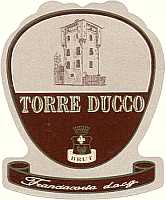
|
|
Franciacorta Brut Torre Ducco |
|
| Catturich Ducco (Lombardy, Italy) | |
| Grapes: Chardonnay (90%), Pinot Blanc (10%) | |
| Price: € 13.00 | Score: |
| This Franciacorta shows an intense golden yellow color and nuances of golden yellow, very transparent, good effervescence, fine and persistent perlage. The nose reveals intense, clean, pleasing and refined aromas which start with hints of bread crust and yeast followed by aromas of banana, hawthorn, apple, pear, plum, grapefruit, hazelnut, honey and praline. The mouth has good correspondence to the nose, an effervescent and crisp attack, however balanced by alcohol, good body, intense flavors, pleasing roundness. The finish is persistent with flavors of hazelnut, banana and plum. Part of the Chardonnay used for this wine ages in barrique. This Franciacorta ages in bottle on its lees for at least 36 months. | |
| Food Match: Pasta with legumes, Roasted fish, Roasted white meat, Stewed fish | |
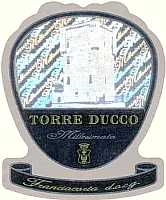
|
|
Franciacorta Pas Dosè Millesimato Torre Ducco 1997 |
|
| Catturich Ducco (Lombardy, Italy) | |
| Grapes: Chardonnay (70%), Pinot Noir (30%) | |
| Price: € 18.00 | Score: |
| This Franciacorta shows a brilliant golden yellow color and nuances of golden yellow, very transparent, good effervescence, fine and persistent perlage. The nose reveals intense, clean, pleasing, refined and elegant aromas that start with hints of yeast, bread crust and hazelnut followed by aromas of banana, acacia, butter, grapefruit, praline, plum, apple and vanilla. The mouth has good correspondence to the nose, a crisp and effervescent attack, however balanced by alcohol, good body, intense flavors, agreeable. The finish is persistent with flavors of grapefruit, apple and hazelnut. Part of the Chardonnay used for this wine ages in barrique. This Franciacorta ages in bottle on its lees for at least 84 months. | |
| Food Match: Roasted fish, Roasted white meat, Stewed meat | |
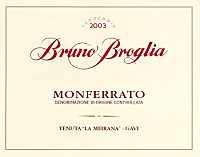
|
|
Monferrato Rosso Bruno Broglia 2003 |
|
| Broglia (Piedmont, Italy) | |
| Grapes: Barbera, Cabernet Sauvignon, Merlot | |
| Price: € 19.00 | Score: |
| This wine shows a brilliant ruby red color and nuances of ruby red, moderate transparency. The nose denotes intense, clean and pleasing aromas which start with hints of black cherry, plum and violet followed by aromas of blueberry, blackberry, black currant and vanilla. The mouth has good correspondence to the nose, a slightly tannic attack and however balanced by alcohol, good body, intense flavors. The finish is persistent with flavors of black cherry and plum. This Monferrato Rosso ages for 18 months in barrique. | |
| Food Match: Roasted meat, Broiled meat and barbecue, Braised and stewed meat | |
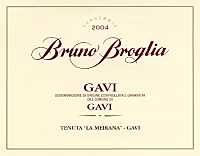
|
|
Gavi di Gavi Bruno Broglia 2004 |
|
| Broglia (Piedmont, Italy) | |
| Grapes: Cortese | |
| Price: € 19.00 | Score: |
| The wine shows an intense greenish yellow color and nuances of greenish yellow, very transparent. The nose denotes intense, clean, pleasing and refined aromas that start with hints of pear, apple and peach followed by aromas of pineapple, hawthorn, litchi, medlar and broom. The mouth has good correspondence to the nose, a crisp attack and however balanced by alcohol, good body, intense flavors, agreeable. The finish is persistent with flavors of pear, pineapple and peach. This Gavi ages in steel tanks. | |
| Food Match: Roasted fish, Stewed fish, Broiled crustaceans | |

|
|
Il Nespoli 2003 |
|
| Podere dal Nespoli (Emilia Romagna, Italy) | |
| Grapes: Sangiovese | |
| Price: € 13.40 | Score: |
| The wine shows a brilliant ruby red color and nuances of garnet red, moderate transparency. The nose reveals intense, clean and pleasing aromas which start with hints of cherry, raspberry and plum followed by aromas of cyclamen, vanilla, licorice and menthol. The mouth has good correspondence to the nose, a slightly tannic attack and however balanced by alcohol, good body, intense flavors. The finish is persistent with flavors of cherry, plum and raspberry. Il Nespoli ages for 12 months in barrique. | |
| Food Match: Stewed meat with mushrooms, Roasted meat, Hard cheese | |
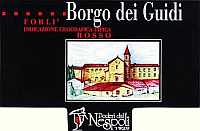
|
|
Borgo dei Guidi 2001 |
|
| Podere dal Nespoli (Emilia Romagna, Italy) | |
| Grapes: Sangiovese (70%), Cabernet Sauvignon (25%), Raboso del Piave (5%) | |
| Price: € 21.00 | Score: |
| This wine shows an intense ruby red color and nuances of ruby red, little transparency. The nose denotes intense, clean, pleasing and refined aromas which start with hints of plum and blueberry followed by aromas of black cherry, black currant, vanilla, licorice, tobacco, menthol, cinnamon and hints of bell pepper. The mouth has good correspondence to the nose, a tannic attack and however balanced by alcohol, good body, intense flavors. The finish is persistent with flavors of black currant, plum and black cherry. A well made wine. Borgo dei Guidi ages for 12 months in barrique followed by 12 months of aging in bottle. | |
| Food Match: Roasted meat, Stewed and braised meat with mushrooms, Hard cheese | |

|
|
Verdicchio dei Castelli di Jesi Classico Superiore Podium 2003 |
|
| Garofoli (Marches, Italy) | |
| Grapes: Verdicchio | |
| Price: € 11.00 | Score: |
| The wine shows a brilliant straw yellow color and nuances of greenish yellow, very transparent. The nose denotes intense, clean, pleasing and refined aromas which start with hints of jasmine, apple and pear followed by aromas of pineapple, hawthorn, broom, honey, citrus fruits, almond and plum. The mouth has good correspondence to the nose, a crisp attack and however balanced by alcohol, good body, intense flavors, agreeable. The finish is persistent with flavors of plum, apple and pear. A well made wine. Verdicchio Podium ages for 15 months in steel tanks followed by 4 months of aging in bottle. | |
| Food Match: Roasted fish, Stuffed pasta, Stewed fish, Roasted white meat | |
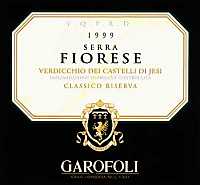
|
|
Verdicchio dei Castelli di Jesi Classico Superiore Riserva Serra Fiorese 2002 |
|
| Garofoli (Marches, Italy) | |
| Grapes: Verdicchio | |
| Price: € 12.50 | Score: |
| This Verdicchio shows a brilliant golden yellow color and nuances of straw yellow, very transparent. The nose reveals intense, clean, pleasing, refined and elegant aromas which start with hints of quince, plum and apricot followed by aromas of hawthorn, broom, pineapple, pear, peach, vanilla, litchi and almond. The mouth has very good correspondence to the nose, a crisp attack and pleasing smoothness, however well balanced by alcohol, good body, intense flavors, agreeable. The finish is persistent with flavors of plum, apricot and quince. A well made wine. Verdicchio Serra Fiorese ages for 11 months in barrique followed by at least 12 months of aging in bottle. | |
| Food Match: Roasted fish, Roasted white meat, Stewed fish, Stuffed pasta with mushrooms | |
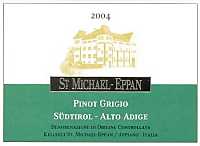
|
|
Alto Adige Pinot Grigio 2004 |
|
| San Michele Appiano (Alto Adige, Italy) | |
| Grapes: Pinot Gris | |
| Price: € 6.00 | Score: |
| This wine shows a brilliant greenish yellow color and nuances of greenish yellow, very transparent. The nose denotes intense, clean and pleasing aromas which start with hints of pear and pineapple followed by aromas of lemon, apple, hawthorn and broom. The mouth has good correspondence to the nose, a crisp attack and however balanced by alcohol, good body, intense flavors. The finish is persistent with flavors of pear and pineapple. This Pinot Gris ages in steel tanks. | |
| Food Match: Fish appetizers, Pasta and risotto with crustaceans, Eggs | |
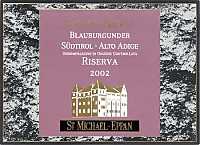
|
|
Alto Adige Pinot Nero Riserva 2002 |
|
| San Michele Appiano (Alto Adige, Italy) | |
| Grapes: Pinot Noir | |
| Price: € 10.70 | Score: |
| This Pinot Noir shows a pale ruby red color and nuances of brick red, moderate transparency. The nose reveals intense, clean, pleasing and refined aromas which start with hints of cherry and raspberry followed by aromas of strawberry, cyclamen, rose, plum, licorice and vanilla. The mouth has good correspondence to the nose, a slightly tannic attack and pleasing crispness, however balanced by alcohol, good body, intense flavors, agreeable. The finish is persistent with flavors of cherry, raspberry and strawberry. This wine ages for 12 months in cask. | |
| Food Match: Roasted meat, Stewed meat with mushrooms | |
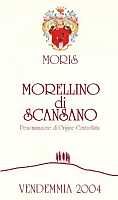
|
|
Morellino di Scansano 2004 |
|
| Moris Farms (Tuscany, Italy) | |
| Grapes: Sangiovese (90%), Cabernet Sauvignon, Syrah (10%) | |
| Price: € 8.00 | Score: |
| This wine shows a brilliant ruby red color and nuances of ruby red, moderate transparency. The nose denotes intense, clean and pleasing aromas which start with hints of raspberry and plum followed by aromas of cherry, strawberry, blueberry, cyclamen and violet. The mouth has good correspondence to the nose, a slightly tannic attack and however balanced by alcohol, good body, intense flavors. The finish is persistent with flavors of cherry, raspberry and blueberry. This Morellino di Scansano ages for 4 months in steel tanks followed by at least 2 months of aging in bottle. | |
| Food Match: Sauteed meat with mushrooms, Stuffed pasta, Broiled meat and barbecue | |
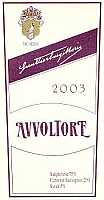
|
|
Avvoltore 2003 |
|
| Moris Farms (Tuscany, Italy) | |
| Grapes: Sangiovese (75%), Cabernet Sauvignon (20%), Syrah (5%) | |
| Price: € 26.00 | Score: |
| The wine shows an intense ruby red color and nuances of ruby red, little transparency. The nose reveals intense, clean, pleasing, refined and elegant aromas which start with hints of black currant, black cherry and plum followed by aromas of blueberry, blackberry, violet, vanilla, cocoa, eucalyptus, licorice and tobacco. The mouth has good correspondence to the nose, a tannic attack and however balanced by alcohol, full body, intense flavors. The finish is persistent with flavors of black currant, plum and black cherry. A well made wine. Avvoltore ages for about 12 months in barrique followed by 6 months of aging in bottle. | |
| Food Match: Game, Roasted meat, Braised and stewed meat, Hard cheese | |
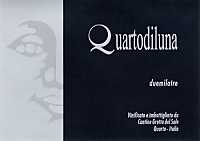
|
|
Quartodiluna 2003 |
|
| Cantine Grotta del Sole (Campania, Italy) | |
| Grapes: Falanghina, Coda di Volpe | |
| Price: € 13.60 | Score: |
| This wine shows a brilliant straw yellow color and nuances of straw yellow, very transparent. The nose reveals intense, clean, pleasing and refined aromas which start with hints of hazelnut and apple followed by aromas of hawthorn, plum, pineapple, vanilla, toasted, broom and almond. The mouth has good correspondence to the nose, a crisp attack and pleasing roundness, however balanced by alcohol, good body, intense flavors, agreeable. The finish is persistent with flavors of apple, plum and pineapple. Quartodiluna ages for 6 months in barrique followed by 4 months of aging in bottle. | |
| Food Match: Stuffed pasta, Roasted white meat, Roasted fish, Fish and mushrooms soups | |
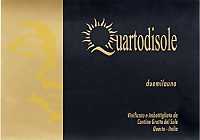
|
|
Quartodisole 2003 |
|
| Cantine Grotta del Sole (Campania, Italy) | |
| Grapes: Piedirosso, Aglianico | |
| Price: € 17.00 | Score: |
| The wine shows an intense ruby red color and nuances of ruby red, little transparency. The nose reveals intense, clean, pleasing and refined aromas which start with hints of black cherry, blueberry and plum followed by aromas of carob, blackberry, vanilla, tobacco, licorice and menthol. The mouth has good correspondence to the nose, a tannic attack and however balanced by alcohol, full body, intense flavors. The finish is persistent with flavors of black cherry, plum and blueberry. A well made wine. Quartodisole ages for 12 months in barrique followed by 4 months of aging in bottle. | |
| Food Match: Game, Roasted meat, Stewed and braised meat | |
MasiSpecialist in dried grapes, Masi represents a fundamental point for the production of wines in Valpolicella and Amarone, a success repeating for more than 30 years with excellent quality wines |
|
Wine, quality, culture and art. These could be the four elements which connect the activity of Masi winery, renowned in the world for its wines, in particular for the ones produced in the Valpolicella area with dried grapes, including Amarone, the great and famous wine from Veneto. Masi is not Amarone only. In fact, the dynamic winery owns vineyards - besides in the classic areas of Veneto and Valpolicella - in Friuli Venezia Giulia, in Tuscany and in Argentina. Masi's wines - winery owned by the Boscaini family - are known and appreciated worldwide for their quality, in particular the renowned Amarone, a wine to which Masi has associated its name. The history of Masi is indissolubly connected to the ones of its vineyards. In fact, the name of the winery derives from “Vaio dei Masi” - that is “tiny valley of Masi” - a vineyard located at Negrar, in the Valpolicella area, and that the Boscaini family - owners of the winery - bought at the end of the eighteenth century and which became their first vineyard.
In the course of the years, the winery has developed thanks to the acquisition of new vineyards located in the classic areas of Valpolicella, Bardolino and Soave, uniquely selecting lands located in the best positions or vineyards having a historical importance. In the last ten years the property of Masi winery also spread in other areas of the Triveneto, in Friuli Venezia Giulia, in Tuscany - project to which is also taking part Serego Alighieri winery - as well as Argentina. Masi's vineyards are all owned by the Boscaini family since six generations. Sandro Boscaini is the chairman of the winery; his brother Sergio is chief wine maker; his cousin Roberto is responsible for logistics; his cousin Dario is responsible for viticultural aspects. In the classic areas in the province of Verona, Masi owns 160 hectares of vineyards (about 395 acres) as well as other lands in which are being planted new vineyards. Many of the wines have the name of the vineyard or cru from which they are from: Mazzano, Campolongo di Torbe, Mezzanella, Vaio Armaron, Casal dei Ronchi, La Vegrona, Campofiorin and Colbaraca. In Friuli Venezia Giulia, near the borders with Veneto, Masi has planted its vineyards in soils suited to the expression of the Venetian style by using autochthonous grapes and vinification methods allowing the production of extremely modern wines. In the vineyards called “Strà del Milione” - in the commune of Castions di Strada, in the Grave area - are being produced the wines “Modello delle Venezie” white and red, as well as the supervenetians Grandarella, obtained by dried autochthonous grapes, and Masianco, produced with Pinot Gris and Verduzzo Friulano. Recently has also been acquired the “del Bello Ovile” estate, in Val d'Orcia, in the borders of the Montalcino area. In these lands have been planted the autochthonous varieties Sangiovese, Canaiolo Nero and Colorino, with the aim of producing two supertuscan wines - probably - from 2006 on. In the same project was also started a collaboration with Ezio Rivella - one of the most influential figures in the Italian wine scene - with the goal of producing Brunello di Montalcino, Rosso di Montalcino and Sant'Antimo in the “Pian di Rota” winery, located near Montalcino.
Masi has also acquired an estate in the Tupungato valley - in the Mendoza region, Argentina - after having scrupulously studied the condition of the place according to its viticultural and enological project. In the beginning were planted 10 hectares (about 2.5 acres) with many varieties, then the project continued with a more precise aim by planting Corvina and Corvinone, the main grapes in the area of Verona, responsible for the uniqueness of Amarone and of superior Valpolicella wines. The local component is represented by Malbec, the most representative red berried grape of Argentina, to which is added - although in a lesser proportion - the international Merlot. The first results in the land of Argentina were released in 1999 with the wines Corbec - produced with Corvina and Malbec grapes, overripe in mats just like Amarone - and Passo Doble, produced with the technique of double fermentation with Malbec e Corvina. Since more than 30 years, Masi collaborates with “Possessioni Serego Alighieri”, the noble family originating from the famous poet Dante and which owns prestigious vineyards in the Valpolicella area since 1353. The result of this collaboration has led to the creation of great wines, including the famous “Amarone della Valpolicella Classico Vaio Armaron”. Masi is leader in the production of historical wines - such as Amarone and Recioto della Valpolicella - by using the technique of grape drying, becoming successful worldwide with the production of seven wines. Five of them are produced from single vineyards (cru), selected by Masi from the 1950's on. Masi has also rediscovered and improved the technique of double fermentation by using whole and slightly dried grapes. The first wines to be produced with this technique were the supervenetians Campofiorin with “ripasso” branding, and its particular selection, Brolo di Campofiorin. The other Masi's supervenetians are Toar, a wine exclusively produced with fresh grapes (non dried) of Verona, and Osar, which has been considered of great interest as an example of modern wine obtained by ancient grapes, produced with the indigenous Oseleta grape. Besides the three Veronese DOC wines of the classic area (Soave Levarie, Valpolicella Bonacosta and Bardolino Frescaripa), Masi also produces wines from selected vineyards: “Colbaraca” for Soave, “Dell'Anniversario Serego Alighieri” for Valpolicella and “La Vegrona” for Bardolino. Today Masi's wines are commercialized - besides Italy - in Canada, China, France, Germany, United Kingdom, Japan, Netherlands, Norway, Sweden, Switzerland and United States of America. The commitment of Masi is not only dedicated to wine. The “Premio Masi” (Masi Award) - created in the middle of the 1970 from an idea of the Veronese writer Cesare Marchi - every year awards a prize to illustrious figures of the world of literature, science, show and economy, who have particularly emphasized the Venetian civilization and the civilization of wine. With the endorsement of Premio Masi are being identified two international awards, respectively dedicated to “Venetian Civilization” and to “Wine Civilization”. Moreover, it is also awarded the special prize “Grosso Veneziano” - awarded whenever specific circumstances occur - given to non Venetian figures who contributed to spread in the world the message of culture and civilization originating from Veneto. The Premio Masi is awarded by the Masi Foundation, established in 2000 and which works in the promotion of Venetian Civilization, in its historical, cultural and productive aspects, in the valuation of wine as a culturally significative product of the Veneto lands. Masi foundation has also the goal of ensuring the continuity over time and the cultural spreading of the award, as well as promoting other events according to the goals of its statute.
|
||||||||||||||||||||
|
Score legend Prices are to be considered as indicative. Prices may vary according to the country or the shop where wines are bought |
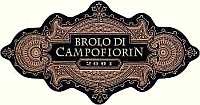
|
|
Brolo di Campofiorin 2001 |
|
| Masi (Veneto, Italy) | |
| Grapes: Corvina (80%), Rondinella (20%) | |
| Price: € 15.90 | Score: |
| The wine shows an intense ruby red color and nuances of garnet red, little transparency. The nose reveals intense, clean, pleasing and refined aromas that start with hints of blackberry, black cherry and plum followed by aromas of violet, blueberry, vanilla, tobacco, licorice, cinchona, cocoa and cinnamon. The mouth has good correspondence to the nose, a tannic attack and however balanced by alcohol, full body, intense flavors. The finish is persistent with flavors of blackberry, black cherry and plum. A well made wine. Brolo di Campofiorin is produced with the double fermentation system “Ripasso”, part of the Corvina grape is dried for 15 days, ages for 36 months in cask followed by 6 months of aging in bottle. | |
| Food Match: Roasted meat, Stewed and braised meat with mushrooms, Hard cheese | |
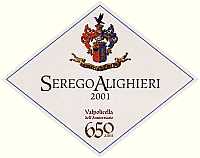
|
|
Valpolicella Classico Superiore dell'Anniversario Serego Alighieri 2001 |
|
| Masi (Veneto, Italy) | |
| Grapes: Corvina (70%), Rondinella (20%), Molinara (10%) | |
| Price: € 18.50 | Score: |
| This wine shows an intense ruby red color and nuances of ruby red, little transparency. The nose reveals intense, clean, pleasing, refined and elegant aromas which start with hints of blackberry, black cherry and plum followed by aromas of violet, blueberry, vanilla, licorice, tobacco, cocoa, mace and pink pepper. The mouth has good correspondence to the nose, a tannic attack and however balanced by alcohol, full body, intense flavors, agreeable. The finish is persistent with flavors of blackberry, black cherry and plum. A well made wine. This Valpolicella ages for 18 months in oak casks, 6 months in cherry wood casks followed by at least 6 months of aging in bottle. | |
| Food Match: Roasted meat, Broiled meat and barbecue, Braised and stewed meat | |
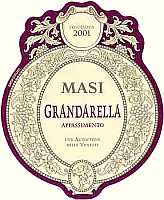
|
|
Grandarella 2001 |
|
| Masi (Veneto, Italy) | |
| Grapes: Refosco dal Peduncolo Rosso (75%), Carmenère (25%) | |
| Price: € 19.90 | Score: |
| Grandarella shows a deep ruby red color and nuances of garnet red, little transparency. The nose reveals intense, clean, pleasing, refined and elegant aromas which start with hints of blackberry, black cherry and plum followed by aromas of violet, tobacco, vanilla, black pepper, licorice, menthol, cocoa, cinnamon, mace and coriander. The mouth has good correspondence to the nose, a tannic attack and however balanced by alcohol, full body, intense flavors, agreeable. The finish is persistent with flavors of blackberry, black cherry and plum. A well made wine. Grandarella is produced with dried grapes, ages for 24 months in cask followed by at least 4 months of aging in bottle. | |
| Food Match: Game, Roasted meat, Braised and stewed meat, Hard cheese | |

|
|
Amarone della Valpolicella Classico Vaio Armaron Serego Alighieri 2000 |
|
| Masi (Veneto, Italy) | |
| Grapes: Corvina (65%), Rondinella (20%), Molinara (15%) | |
| Price: € 38.90 | Score: |
| The wine shows an deep ruby red color and nuances of garnet red, little transparency. The nose reveals intense, clean, pleasing and refined aromas that start with hints of plum jam, black cherry and blackberry followed by aromas of blueberry, violet, vanilla, tobacco, pink pepper, cinnamon, clove and cocoa. The mouth has good correspondence to the nose, a tannic attack and however balanced by alcohol, full body, intense flavors, agreeable. The finish is persistent with flavors of blackberry and plum. A well made wine. This Amarone ages for 3 years in oak casks, 4 months in cherry wood cask, followed by at least 5 months of aging in bottle. | |
| Food Match: Game, Roasted meat, Braised and stewed meat, Hard cheese | |
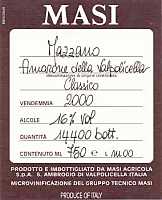
|
|
Amarone della Valpolicella Classico Mazzano 2000 |
|
| Masi (Veneto, Italy) | |
| Grapes: Corvina (75%), Rondinella (20%), Molinara (5%) | |
| Price: € 69.00 | Score: |
| This Amarone shows a brilliant ruby red color and nuances of garnet red, little transparency. The nose reveals intense, clean, pleasing, refined and elegant aromas which start with hints of blackberry, plum and black cherry followed by aromas of blueberry, black currant, violet, vanilla, licorice, tobacco, mace, chocolate and cinnamon. The mouth has very good correspondence to the nose, a tannic attack and however balanced by alcohol, full body, intense flavors, agreeable. The finish is persistent with flavors of blackberry, black cherry and plum. A well made wine. This Amarone ages for 3 years in casks followed by at least 6 months of aging in bottle. | |
| Food Match: Game, Roasted meat, Braised and stewed meat, Hard cheese | |
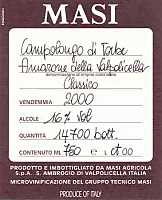
|
|
Amarone della Valpolicella Classico Campolongo di Torbe 2000 |
|
| Masi (Veneto, Italy) | |
| Grapes: Corvina (70%), Rondinella (25%), Molinara (5%) | |
| Price: € 59.00 | Score: |
| This Amarone shows an intense ruby red color and nuances of garnet red, little transparency. The nose reveals intense, clean, pleasing, refined and elegant aromas which start with hints of blackberry, black cherry and plum followed by aromas of dried violet, blueberry, vanilla, licorice, tobacco, pink pepper, cocoa, cinnamon, mace and hints of leather and enamel. The mouth has excellent correspondence to the nose, a tannic attack and however balance by alcohol, full body, intense flavors, agreeable. The finish is very persistent with long flavors of blackberry, plum and black cherry. A very well made wine. This Amarone ages for 3 years in cask followed by at least 6 months of aging in bottle. | |
| Food Match: Game, Roasted meat, Braised and stewed meat, Hard cheese | |
| Masi Agricola Spa - Via Monteleone - 37020 Gargagnago, Verona (Italy) - Tel.+39 45 6832511 Fax +39 45 6832535 - Winemaker: Sergio Boscaini, Lanfranco Paronetto, Andrea Dal Cin - Established: 1972 - Production: 3.500.000 bottles - E-Mail: masi@masi.it - WEB: www.masi.it |
Cellar Journal |
|
This section is reserved to wine producers who want to publish news and information about their business, to announce new products or just for communicating to customers information and promotions about their products and activity. Send news to be published to our e-mail address.
|
News |
|
In this section are published news and information about events concerning the world of wine and food. Whoever is interested in publishing this kind of information can send us a mail to our address.
|
Matching Wine and LegumesImportant protagonists of the famous Mediterranean diet, legumes are the base of countless tasty recipes, excellent companions for the matching with wine |
|
The Mediterranean diet is considered everywhere in the world a correct nutritional model, balanced and healthy. One of the main characteristics of this model is represented by the considerable consumption of vegetables, cereals and legumes, fundamental elements in the nutritional customs of the countries coasting the Mediterranean area, and in particular Italy, Spain and Greece. Nutritive and tasty, legumes have represented for the history of humans a precious and fundamental resource in nutrition: during the terrible periods of famine they contribute to feed and save millions of people. In their humble aspect, legumes represent an important nutritional resource, thanks to their high content in proteins and carbohydrates, and when properly associated to other foods - such as cereals - they make a complete meal. The relative simplicity with which legumes can be found - as well as their low cost - they represented for centuries a fundamental nutritional resource for the less well-off people in every country of the world. Moreover, legumes are an excellent source of water-soluble fibers, an important nutritional help for the modern diet notoriously poor and deprived of these useful components. In the course of centuries, legumes have been protagonists of countless tasty recipes, most of them belonging to the gastronomical and cultural rural tradition, which are appreciated and common even nowadays. In fact, there are countless soups in which legumes are the main ingredients - frequently using more varieties at the same time - as well as countless are the soups in which legumes are associated to many cereals. The association of legumes and cereals allows the preparation of rich and complete dishes according to a nutritional point of view, something which was well known to our ancestors who used to associate pasta and legumes, a very common association in every region of Italy. From legumes are also obtained flours with which can be prepared bakery products or dough suitable for frying.
|
|
Legumes belong to the family of leguminosae and most of them are from Latin America. There are more than 14,000 different varieties of legumes, however only few tens of them are used for nutritional purposes. In Europe legumes began to spread everywhere after the journeys of explorers in the so called New World, when they started to load the holds of their ships with beans. In the Old World, legumes were known since the times of Etruscans, in particular dolici - the so called black-eyed beans - considered as a sacred food destined to priests. It is believed beans known at those times - such as dolici and lentils - are from Asia Minor, in particular, lentils are even mentioned in the Bible. Legumes have always characterized the nutrition of the Mediterranean people and from the beginning of the 1500's on, they also became common in other European countries, they started spreading in the northern regions of Italy first, then in France and in Germany.
Beans and lentils certainly are the most common legumes in the world, generally sold dried - even for reasons of keeping - they are used for the preparation of dishes as well as side dishes for meat based recipes. The family of legumes also includes other important varieties used for nutritional purposes, such as chickpeas, chickling vetch (grass pea), broadbeans, peas and soybeans. Among them, chickling vetch certainly is the less known, despite it was once very appreciated, today it is very hard to find and few people know it. Indeed, chickling vetch is an excellent legume with which it is possible to prepare tasty soups, although, as opposed to the other legumes, it needs a longer soaking time. Although in ancient times it was very common in the Mediterranean area, in recent times, chickling vetch has become the typical legume of Umbria and of Central Italy, however even in these areas its spreading is pretty limited and it is now considered a food destined to the few people who are still capable of appreciating it. Even peas are legumes from the Mediterranean area and they were already known in ancient times: archaeological researches have in fact discovered their presence in Egyptian pyramids and in the ruins of ancient Troy. Of round aspect and green colored, peas - as opposed to most of legumes - are usually consumed fresh, with a basically sweet taste, they are used for the preparation of side dishes, soups, sauces for the condiment of pasta and rice, puddings and purees. There are many varieties of peas and all of them are classified into two categories: peas to be shelled and peas to be consumed as a whole, that is peas of which can be consumed the pod as well, such as taccole, typical in Lombardy. Whereas peas to be shelled are being commercialized both dried and fresh - usually boiled and canned - the other type of peas are commercialized fresh only. Among the most ancient legumes are also included lentils, with their typical flat shape, they have always been a fundamental food for ancient people and they are appreciated still today. Lentils are usually commercialized dried and their consumption generally requires a short period of soaking before being cooked. Lentils are also suited for the preparation of side dishes - boiled and seasoned with oil, salt and black pepper - as well as for the preparation of soups, sauces for pasta and rice, creams and purees. Among legumes of Mediterranean origin, there are also chickpeas, known since the times of ancient Egyptians who destined them to the feeding of slaves and of the well-off social classes. Even ancient Romans appreciated chickpeas very much, in particular fried in oil, a tradition which is still alive in the regions of south Italy and in particular in Sicily, where it is being used chickpeas flour to make the traditional panelle. Chickpeas are commercialized dried and, after a proper soaking in water, they are boiled and consumed seasoned with oil and black pepper, or for the preparation of side dishes. Chickpeas are also used in association with pasta and for the preparation of soups, roasted are consumed like dried fruit. Chickpeas flour is also used for the preparation of pudding and pizzas, such as the classic farinata in Liguria (Italy). Known since before the bronze era, broadbeans are legumes from the Mediterranean area, very common among ancient Romans and Greeks, they represented a fundamental food in the Middle Age. Broadbeans are usually commercialized fresh, both shelled as well as with the pod, usually consumed raw and seasoned with salt, or matched to pecorino cheese. Broadbeans are also used for the preparation of soups and associated to pasta, as well as simply boiled and seasoned with oil and black pepper. Coming from Easter Asia, soybean is one of the most important legumes for worldwide economy. Very rich in proteins, it is widely used in eastern countries for the preparation of dishes and from which are being obtained many byproducts, from sauces to cheese. The most common varieties of soybean are yellow, green and red. With these soybean varieties are obtained many byproducts, such as sauces (tamari, shoyu), condiments (miso, natto), oil, flour and spaghetti. With yellow soybean is also prepared a milk from which are being produced yogurt and ice creams, properly processed with coagulating substances, is used for the production of tofu. In the western world - as opposed to the eastern traditions - yellow soybean is generally consumed boiled and seasoned with oil and black pepper. Beans are the varieties which are commonly associated to the family of legumes. Most of the beans known in the western world are from Latin America, whereas a small part of them are from the Mediterranean area or from Asia Minor. Beans are the great protagonists in soups and, associated to cereals, they make a complete food according to a nutritional point of view. Beans are consumed both after having been boiled, seasoned with oil and black pepper, and cooked with tomatoes and other ingredients, as well as boiled and drained, served as a side dish. The most common varieties of beans are borlotto, cannellino, black-eyed (dolici), crown spanish, toscanelli, Lima, zolfini, coco, red and black. Moreover, there are varieties of beans which can be consumed with their pods - called greenbeans - boiled and served as a side dish seasoned with oil, vinegar and black pepper. Beans are also used for the preparation of countless recipes, soups, in association with pasta and purees. In some areas of Italy, beans are usually cooked with meat, in particular with pork's skin or sausages.
|
||||||||||||
|
Legumes are commercialized in many forms: fresh, dried and canned. Because of their practicalness and the less time required for the preparation, most of the consumers prefers canned legumes, even though they have an inferior taste. It is always advisable to use fresh or dried legumes, even tough they require a longer time for cooking: the result certainly is superior. Fundamental is the quality of dried legumes: they must not show faults, holes or wrinkles - a characteristic which signals the presence of parasites - as well as it is important the absence of humidity, responsible for moulds. Dried legumes - before being cooked - requires a soaking in cold water for a variable time according to variety and type, usually from 6 to 8 hours. The quantity of water required for the soaking will be equal to six times the weight of the dried legumes. At the end of soaking it is necessary to rinse legumes in water and therefore they can be cooked. In order to boil legumes it is appropriate to use a quantity of water equal to two times and a half the weight of soaked legumes. It is also good to remember it is preferable avoiding the adding of salt during cooking because this would harden legumes. According to the traditions and to the recipes, during the cooking of legumes, it can be added aromatic herbs, such as sage or rosemary. Cooking times vary according to the type and variety. Indicative times can be of 60 minutes for lentils, 90-120 minutes for beans, 2-3 hours for chickpeas. As legumes tend to break during cooking, it is best not to stir them excessively, saved the case when it is necessary to make sure they did not stick to the bottom of the pot. At the end of cooking it will then added salt - better in form of crystals and according to taste - and allow the legumes to rest for about 30 minutes before consumption. After cooking, legumes can be consumed in their water or drained and added to other ingredients, according to the recipe. Legumes after having been boiled, can in fact be added to tomato and vegetables sauces - to be used for the condiment of pasta - to the broth for the preparation of soups, drained and properly seasoned, served as a side dish.
|
|
Legumes are a food rich in proteins and carbohydrates, their content in fats is pretty low. As for most of the ingredients, legumes are consumed after having been properly seasoned or after having been added to other ingredients. The basically sweet taste of legumes - because of the high quantity of carbohydrates - requires crisp or effervescent wines, therefore white, rose, sparkling or slightly sparkling wines, generally make a good choice. The high content in proteins, generally responsible for a more or less accentuated salivation in the mouth, requires a wine with a good alcohol volume or a moderate astringency, therefore red wines with a modest content in tannins are particularly suited for the matching with legumes. In soups, in the association with pasta and in the dishes made of meat, it will be important the evaluation of all the ingredients used for the preparation of the recipe. In soups, usually rich in vegetables and legumes, the above consideration for the choice of a wine are certainly valid. In recipes of pasta and legumes - such as pasta and chickpeas, pasta and beans or pasta and broadbeans - it is important the evaluation of the base sauce used for the condiment, in which are frequently found tomato, lard, olive oil and bacon, as well as spices and aromatic herbs. In these cases it is appropriate a wine of good structure - even red - and having a good roundness. In the recipes of legumes and meat - such us in the case of beans or lentils with sausages, or in case legumes are being served as a side dish for meat recipes - the choice will mainly be oriented to red wines having a structure appropriate to the succulence of the meat and to the cooking technique. In this case, can also be used sparkling red wines - such as Lambrusco - where the effervescence will be useful in balancing the high quantity of carbohydrates contained in legumes, whereas the astringency and the body will be useful in balancing the succulence caused by the proteins of the meat and legumes.
|
PumpkinFamous for Halloween, very versatile in cooking, cosmetics and medicine, pumpkin is also used as a container and tool. No other vegetable probably owns all of these characteristics |
|
Pumpkin, that is Cucurbita pepo L., belongs to the Cucurbitaceae family, genre Cucurbita. Pumpkin is a herbaceous annual plant, with a climbing trunk or creeping on the ground, in some varieties can reach the length of some meters, whereas in others gets a bushy aspect, it is covered by hard fluff and sometimes having thorns as well. Leaves have an oval-stretched shape with a heart-shaped base. Flowers have pentagonal shaped peduncles. Male flowers are grouped in bunches at the base of leaves and have a calyx made of five wiry parts, whereas female flowers are solitary. The flowers have a bell shaped golden yellow corolla. Fruits are very variable in shape and in size according to variety, from large spherical to stretched pear shape, with a smooth or wrinkled surface. In the pulp are contained many flat oval seeds.
The most known varieties of pumpkins are Cucurbita maxima (sweet pumpkin) and Cucurbita moschata. Cucurbita maxima has a fruit - that is the part commonly known with the name of pumpkin - of pretty big size, it can also weigh 80 kilograms (176 pounds). To this species belongs the big wintertime pumpkins, with a turban shaped aspect, as well as the big oval shaped pumpkins, with a yellow-orange pulp, pretty floury and with a basically sweet taste. The skin of ripe pumpkin shows a green-gray or yellow color as well as orange-red. Pumpkins belonging to the Cucurbita moschata genre are hollow, of average size and dark green or yellow-orange color, have a sweet and soft pulp. Finally, Cucurbita Pepo is the family to which belong the so called zucchini. As pumpkins are not used in kitchen or for nutritional purposes only, it should be remembered some types are generally used for cosmetics or for the making of containers and tools. Wherever in the world men have learnt to make containers from pumpkins. For example, in Africa with hollow pumpkins men are used to make water operated pipes, where the smoke produced by the small burner is sent through a wood cylinder in the water contained in the pumpkin and in the upper part there is a hole from which filtered smoke is being inspired. Some varieties of pumpkins belonging to the Cucurbita Lagenaria genre, when they reach full ripeness, have a very hard skin, and once were cultivated in many countries in order to make containers, flasks for wine or water, and even funnels. For this reason Lagenaria pumpkin is also called “Wine Pumpkin”, as after having been dried, the inside shows a cavity which can be used for keeping or transporting wine, water and other liquids. Some small sized pumpkins are used - after having been dried and divided into two halves - as spoons or ladles. Pumpkin is sown in springtime and get full ripeness in August. For nutritional purposes are being used three species only: Cucurbita Maxima, Cucurbita Moschata and Cucurbita Pepo. Pumpkin requires a tempered climate, with a temperature ranging from 18°C (64°F) to 24°C (75°F). The best temperature for vegetation ranges from 10°C (50°F) to 25°C (77°F); in case it is sown at a temperature lower than 10°C (5'°F), germination is delayed until temperature does not reach an acceptable level. As for soil, pumpkin is not very demanding, it adapts itself to every type, however to get the best results it is appropriate to remember it prefers a fresh and soft soil, of average composition, rich in organic substances, with no stagnation of water and slightly acid. In case it is wished to obtain large fruits, it will enough to keep plants apart - six or seven meters one from each other should be enough (19-22 feet) - and in the middle of the season it will be left just one fruit to the plant. The soil must be well manured since the beginning of the cultivation in order to avoid an excessive use of fertilizers which would favor the formation and development of leaves instead of fruits. It will be enough to water the plants once a week while remembering to put a wood support under the pumpkin in order to avoid the fruit to get rotten. It is highly probable pumpkin is from Central America, in fact the first pumpkin seeds were found in Mexico and are dated back to the period from 6,000 to 7,000 b.C. In North America yellow pumpkin was one of the main foods of indigenous people: the first settlers learnt from them to cultivate and use pumpkin. Pumpkin - together with potatoes and tomatoes - has been among the first vegetables imported in Europe after the discovery of America.
|
||||||||||||
|
Before purchasing a pumpkin it should be paid attention to some factors in order to choose a high quality product. First of all, pumpkin must be fresh and ripe: when slightly struck with knuckles, pumpkin must emit a hollow sound. Check the peduncle: it must be soft and well anchored to the pumpkin, the skin must not have any bruise. Because of its size, pumpkin is frequently bought is cut parts instead of the whole fruit. In this case it is good to check the cut part is not dry, the pulp must be hard and with a ripe aspect and that seeds are still slippy and wet. Cucurbita maxima is probably the most used variety in kitchen as it is suited for the preparation of many dishes. The other “long” varieties are best suited for the preparation of soups together with other vegetables. Pieces of pumpkin can be kept in the refrigerator - in the vegetable section - preferably wrapped in a film and consumed within few days as they tend to easily dehydrate. In case pumpkins are bought as a whole, it is good to remember they can be kept all wintertime long in a dark, fresh and dry place. In case it is needed a longer keeping, it is enough to cut the pulp in small cubes, to boil them for some minutes in hot water, and therefore they can be be frozen.
|
|
The pulp of pumpkin contains many active principles and in particular carotenoids, mucilages and pectic substances. The seeds mainly contain phytosterols, fat oils and phytochelatin. The pulp and juice have laxative and diuretic effects, whereas, for external use, it can be used as a cosmetic treatment for the skin, a traditional remedy to soften and revitalize skin. From fresh and crushed seeds can be extracted an oil with a dark color and a pungent smell; toasted and salted are an excellent snack. The main medical property of seeds is a vermifuge action, in particular against tapeworm. This property derives from an aminoacid - cucurbitine - which paralyzes the tapeworm and causes its detachment from the bowel. The use of seeds as a vermifuge is well tolerated and has no contraindications, even tough its efficiency cannot be compared to male fern, however - as opposed to it - has the advantage of having no side effects and to allow the repetition of the treatment in case it did not work properly. As a laxative, it can be used pumpkin juice to be drunk in the morning on an empty stomach. It should be remembered, despite these remedies can be considered harmless, it is always best to ask a doctor or a specialist. The pulp of pumpkin has few calories: 100 grams of pumpkin pulp contain just 15 calories. Just like carrots and other yellow-orange colored vegetables, pumpkin contains high quantities of vitamin A and betacarotene, it is also rich in vitamin C, potassium and mineral salts. According to some researches, pumpkin - by keeping a correct water balance in the organism - is useful for the prevention of cancer. The pulp can be used in many ways, besides cooking, for example as a remedy for skin inflammations. Seeds, besides being useful against tapeworm, have qualities for the prevention of urinary tract disturbs. From the pulp can be obtained an extract which can be added to milk or to fruit juice, and can be used as a remedy for gastric disturbs and for prostate. With pumpkin pulp can be prepared a face-pack. For its preparation is enough to have a slice of raw pumpkin, a handful of seeds and some honey, mix all ingredients and spread on the face allowing it to work for some minutes: the skin will benefit from this treatment.
|
AquavitaeReview of Grappa, Distillates and Brandy |
|
|
| Distillates are rated according to DiWineTaste's evaluation method. Please see score legend in the "Wines of the Month" section. |
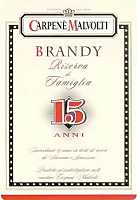
|
|
Brandy Riserva di Famiglia 15 Anni |
|
| Carpenè Malvolti (Veneto, Italy) | |
| Raw matter: Selection of Wines | |
| Price: € 17.00 - 70cl | Score: |
| This brandy shows an intense amber yellow color, limpid and crystalline. The nose denotes intense, clean, pleasing and refined aromas of vanilla, toasted, cocoa, hazelnut, honey, licorice, grape flowers, with almost imperceptible alcohol pungency. In the mouth has intense flavors, good roundness, perceptible alcohol pungency which tends to dissolve rapidly, good correspondence to the nose, agreeable. The finish is persistent with flavors of hazelnut, honey and licorice. This brandy ages for at least 15 years in small slavonian and limousine oak barrels. Alcohol 40%. | |
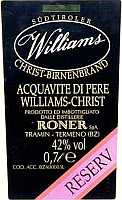
|
|
Acquavite di Pere Williams Christ Reserv Extra |
|
| Roner (Alto Adige, Italy) | |
| Raw matter: Williams Christ Pears | |
| Price: € 13.40 - 70cl | Score: |
| This fruit brandy is colorless, limpid and crystalline. The nose denotes intense, clean, pleasing and refined aromas of pear, acacia and anise, with almost imperceptible alcohol pungency. In the mouth has intense flavors, very pleasing, good roundness, perceptible alcohol pungency which tends to dissolve rapidly, excellent correspondence to the nose, very agreeable and balanced sweet hints. The finish is very persistent with long flavors of pear. A well made fruit brandy produced with double distillation in bainmarie alembic still. Alcohol 42%. | |
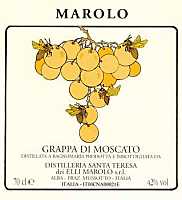
|
|
Grappa di Moscato 2004 |
|
| Santa Teresa Marolo (Piedmont, Italy) | |
| Raw matter: Pomace of Muscat Blanc | |
| Price: € 25.00 - 70cl | Score: |
| This grappa is colorless, limpid and crystalline. The nose reveals intense, clean, pleasing and refined aromas of grape, peach, praline, banana and sage, with almost imperceptible alcohol pungency. In the mouth has intense flavors, agreeable, good roundness, perceptible alcohol pungency which tends to dissolve rapidly, good correspondence to the nose, balanced sweet hint. The finish is persistent with flavors of grape and peach. A well made grappa distilled in bainmarie discontinuous alembic still. Alcohol 42%. | |
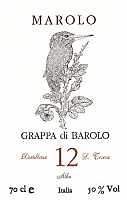
|
|
Grappa di Barolo 12 anni 1993 |
|
| Santa Teresa Marolo (Piedmont, Italy) | |
| Raw matter: Pomace of Nebbiolo from Barolo | |
| Price: € 43.00 - 70cl | Score: |
| This grappa shows an intense amber yellow color, limpid and crystalline. The nose reveals intense, clean, pleasing, refined and elegant aromas of prune, cherries macerated in alcohol, vanilla, licorice, honey, cocoa, tobacco, dried violet, mace and almond, with almost imperceptible alcohol pungency. In the mouth has intense flavors, good roundness, perceptible alcohol pungency which tends to dissolve rapidly, excellent correspondence to the nose, very agreeable. The finish is very persistent with long flavors of prune, licorice, honey and cocoa. A well made grappa distilled in bainmarie discontinuous alembic still. It ages for 12 years in small oak and acacia barrels. Alcohol 50%. | |
Wine Parade |
|
|
| The best 15 wines according to DiWineTaste's readers. To express your best three wines send us an E-mail or fill in the form available at our WEB site. |
| Rank | Wine, Producer | |
|---|---|---|
| 1 |
| Palazzo della Torre 2000, Allegrini (Italy) |
| 2 |
| Aglianico del Vulture La Firma 2002, Cantine del Notaio (Italy) |
| 3 |
| Amarone della Valpolicella Classico 1998, Santa Sofia (Italy) |
| 4 |
| Montepulciano d'Abruzzo Riparosso 2001, Illuminati (Italy) |
| 5 |
| Trento Talento Brut Riserva Methius 1998, Dorigati (Italy) |
| 6 |
| Colli Orientali del Friuli Rosazzo Bianco Terre Alte 2002, Livio Felluga (Italy) |
| 7 |
| Chablis Grand Cru Les Clos 2002, Domaine Billaud-Simon (France) |
| 8 |
| Riesling Cuvée Frédéric Emile 1999, Maison Trimbach (France) |
| 9 |
| Riesling Central Otago 2004, Felton Road (New Zealand) |
| 10 |
| Brunello di Montalcino 1999, Castello Banfi (Italy) |
| 11 |
| Harmonium 2001, Firriato (Italy) |
| 12 |
| Amarone della Valpolicella Classico 2000, Zenato (Italy) |
| 13 |
| Edizione Cinque Autoctoni 2001, Farnese (Italy) |
| 14 |
| Wine Obsession 2001, Vignamaggio (Italy) |
| 15 |
| Rêve 2001, Velenosi Ercole (Italy) |
| |||||||
Privacy Policy | |||||||


| Copyright © 2002-2024 Antonello Biancalana, DiWineTaste - All rights reserved |
| All rights reserved under international copyright conventions. No part of this publication and of this WEB site may be
reproduced or utilized in any form or by any means, electronic or mechanical, without permission in writing from DiWineTaste. |